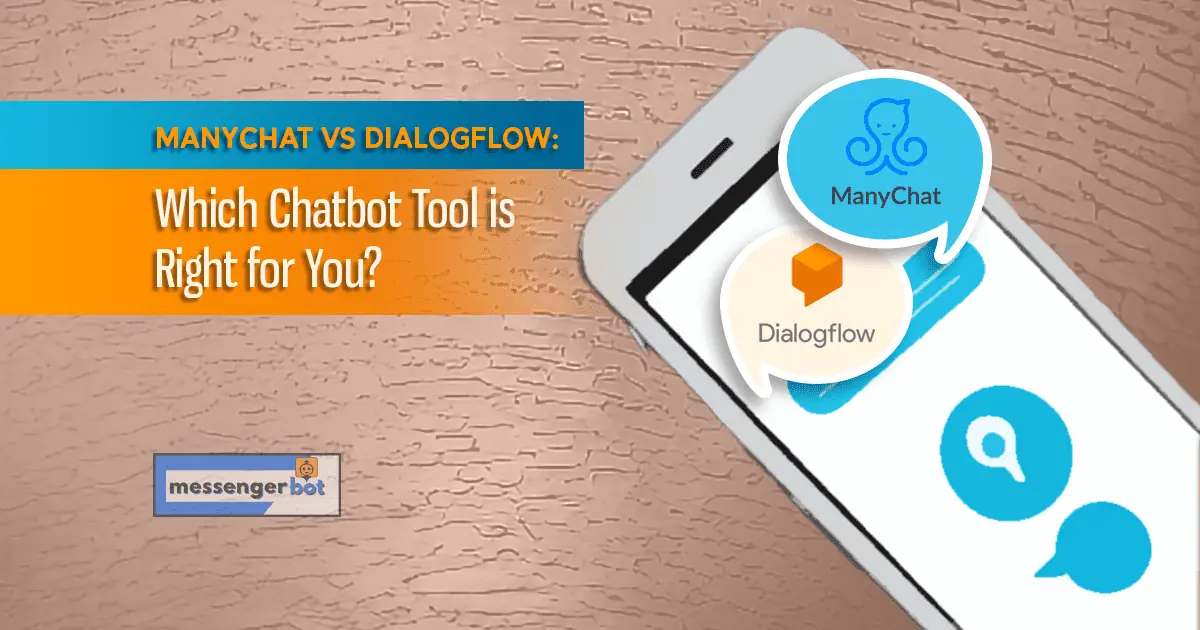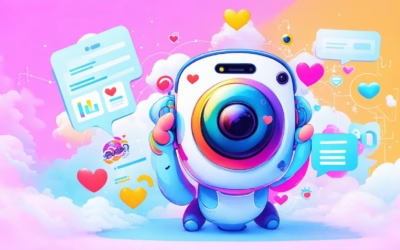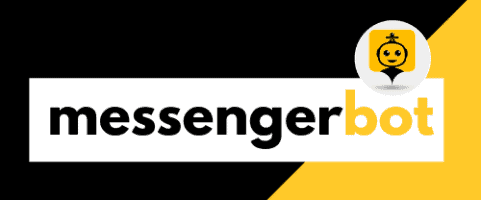Chatbots are the hottest trend in marketing. They offer many benefits, such as providing customer service 24/7 and automating repetitive tasks like email follow-ups. But which chatbot tool should you use? In this blog post, we will compare two of the most popular chatbot tools: Manychat and DialogFlow.
What is a chatbot?

A chatbot is a virtual assistant that can communicate with customers and automate your business processes.
It is still an emerging technology, but it’s getting more and more popular as people realize how useful chatbots can be for their businesses. Chatbot tools make creating custom chatbots simple to do even if you don’t have any programming skills or experience.
How do chatbots work?
Chatbots are a form of artificial intelligence that uses text or voice commands to have a conversation with a human. This technology is used in many applications, including sales and customer service.
Chatbots are great for taking care of simple tasks such as scheduling a meeting, looking up information, and answering basic questions. Chatbots can also be used to provide the first layer of customer service to screen calls when business is busy or unavailable.
Many chatbot tools are available today that help you create your own bot without any programming required.
How are chatbots different from live chats?
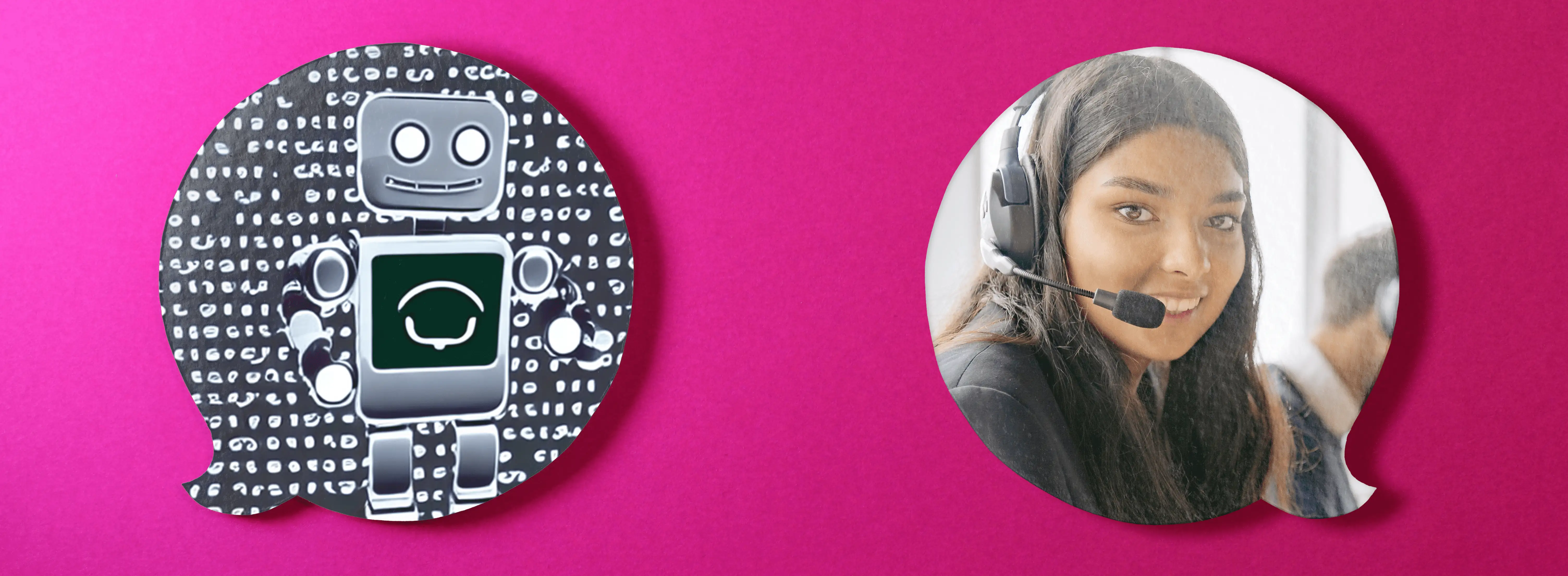
Live chats involve a human being communicating with another human being, in real-time. Chatbots, on the other hand, are powered by artificial intelligence (AI) and can communicate with humans or other chatbots. This makes them an ideal tool for automating customer service tasks or providing instant help to customers.
What are the various types of chatbots?
There are three main types of chatbots. First is the basic chatbot, second is the AI bot which uses machine learning to learn from conversations and third is a smart assistant.
Basic Chatbots are used for simple tasks that have limited information input. Artificial Intelligence bots use machine learning algorithms that enable them to understand user questions or demands by referencing data gathered from previous interactions with similar queries. The Smart Assistant chatbot type is a more advanced AI bot that can understand natural language processing and can provide recommendations or solutions to problems.
Each of these chatbot types has different capabilities, so it’s important to determine what you want your chatbot to do before deciding which tool is right for you.
How can chatbots improve customer experience?
Chatbots are becoming increasingly popular for customer service, and for good reason. They can improve customer experience by providing an instant way to get help and by automating simple tasks.
How to make a chatbot?
The best way to get started is by using a chatbot builder. Chatbot builder tools make it easy for you to create a chatbot without having to write any code.
What makes a great chatbot builder?

A great chatbot builder is simple to use, with a free trial and built-in customer support.
Chatbot builder is great when it has good features and strong integrations.
A great chatbot builder provides a wide variety of features and easy integration with other tools, such as webpages or social media platforms.
What is ManyChat?
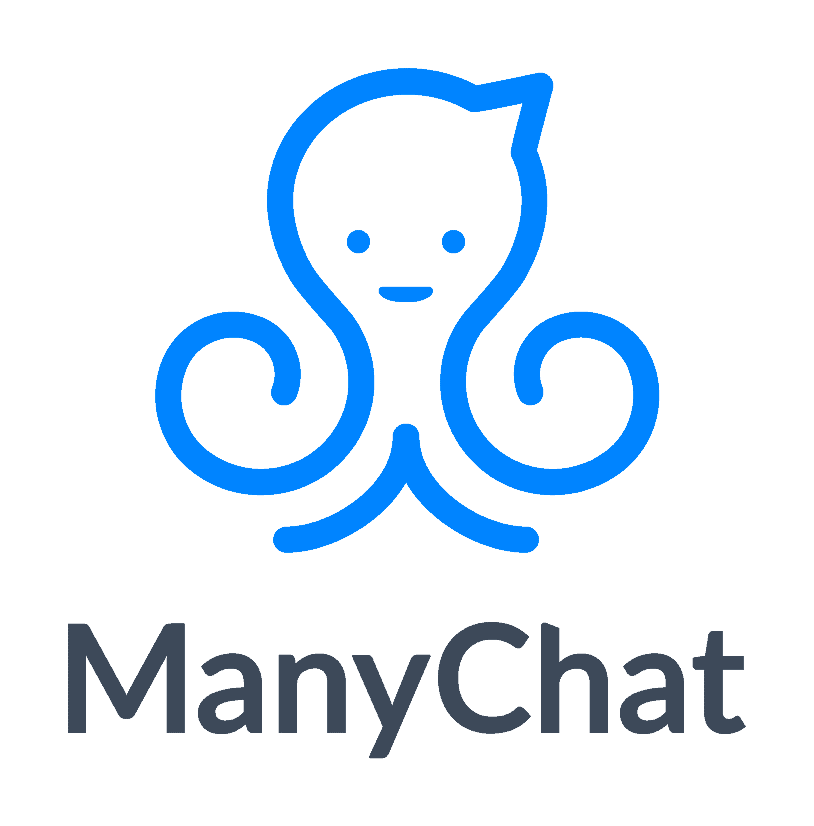
ManyChat is a chatbot tool that allows you to create and manage Facebook Messenger chats with your customers. It offers a wide range of features, including the ability to create automated messages, capture leads, and send broadcasts.
ManyChat is a great tool for businesses that want to create basic chatbots or manage more complex conversations with their customers.
What is Dialogflow?

Dialogflow (formerly known as Api.ai) is a natural language processing platform that helps you design and build chatbots. It offers an easy-to-use interface, along with a wide range of features to help you create sophisticated chatbots.
Pros of Dialogflow
Dialogflow’s pros are its built-in integrations with Google Assistant, which allows you to expand your chatbot’s capabilities. Users can query the bot using voice commands on Google Home or via text for pre-made queries about schedules and reminders.
It has more than 100 services that developers can tap into while building bots (like Salesforce, Twitter, Slack).
Dialogflow’s NLP technology can read intent from a user’s text to determine the best response.
Pros of Dialogflow
Dialogflow’s pros are its built-in integrations with Google Assistant, which allows you to expand your chatbot’s capabilities. Users can query the bot using voice commands on Google Home or via text for pre-made queries about schedules and reminders.
It has more than 100 services that developers can tap into while building bots (like Salesforce, Twitter, Slack).
Dialogflow’s NLP technology can read intent from a user’s text to determine the best response.
Cons of Dialogflow
Dialogflow is not free, and its pricing can be beyond the budget of small businesses
Dialogflow bots are only on Facebook Messenger. Manychat has more channels like SMS/Kik etc.
Dialogflow has more features, but Manychat is easier to use
Pros of ManyChat
Manychat is a chatbot tool that is easy to use and can be integrated with Facebook.
ManyChat has a lot of built-in features, such as the ability to send automated messages, create chatbots, and track the results.
ManyChat is also affordable.
Cons of ManyChat
ManyChat has a lot of great features, but it also has some drawbacks like limited integrations, no natural language processing, poor customer support, and is not as user-friendly as DialogFlow.
DialogFlow vs ManyChat Comparison
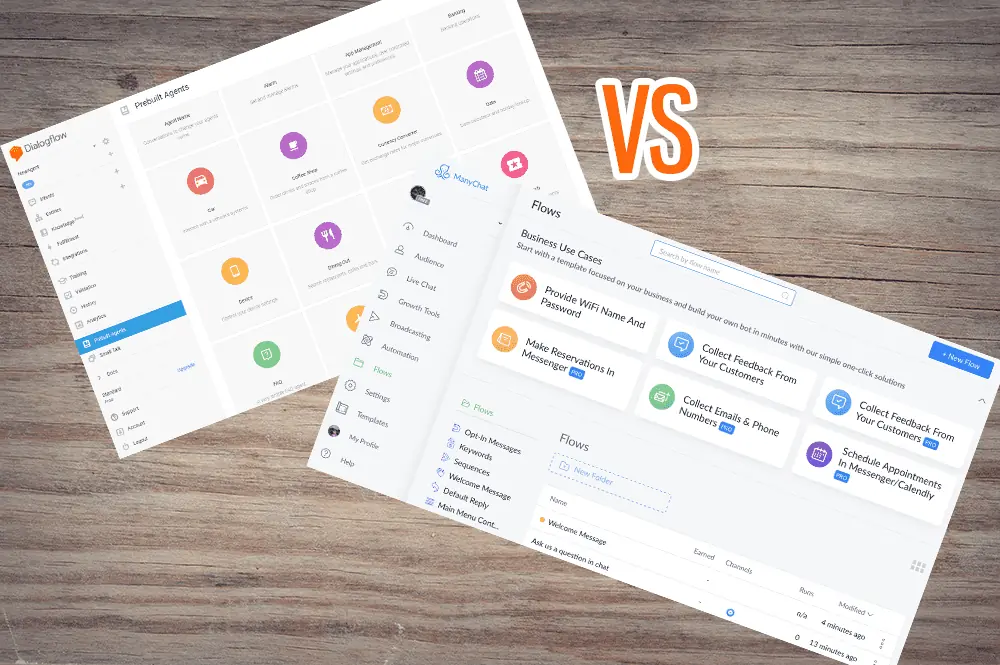
Dialogflow and Manychat are two of the most popular chatbot-building tools available. They both have their pros and cons, but which one is the best choice for you? In this article, we’ll compare Dialogflow and Manychat to help you decide.
Interface
The interface is what you see on your screen or device. It’s how a user interacts with the website including what they can click, where it takes them, and more. A good interface will make using an app feel intuitive for users while bad interfaces are often confusing or cumbersome to use through needless complexities.
Marketing tools should be simple to use and have a great interface. This is because marketers need to be able to quickly learn how to use the tools and complete tasks without any major issues. If something takes too long to learn or isn’t very user-friendly, it can impact productivity and the outcome of a project.
That’s why good interface design is so important when it comes to marketing tools. It can make the difference between a tool that’s used often and one that gathers dust on the shelf.
Dialogflow’s interface is straightforward to use. You can create a new agent from the top of your screen by clicking on ‘Create Agent’ which will bring you through a series of questions about what type of bot this is, how it should be used etc.
The interface then shows you some sample code that you can edit with every available trigger for the chatbot. You can also see the different ways that users can interact with your chatbot, such as through a chat window, Facebook Messenger or on a website.
Overall, Dialogflow’s interface is simple to use and makes creating chatbots easy for anyone who has basic coding knowledge.
Manychat’s interface is also easy to use. You can create a new chatbot by clicking ‘Create A Chatbot’ and then answering some basic questions about your bot such as what type of conversation you want it to have, how often the user should get notifications etc.
Once you’ve finished creating the chatbot, there will be an input box for typing in your code. You can also create new messages or use the existing ones if you want to edit them, which is useful for segmenting users based on what they say so that your chatbot responds accordingly.
Overall, Manychat’s interface is simple and easy to understand how it works even without much coding knowledge.
In terms of interface, both Manychat and Dialogflow are simple to use. However, ManyChat has a better interface because it’s easier to understand how it works compared to DialogFlow which is slightly more complex.
Users
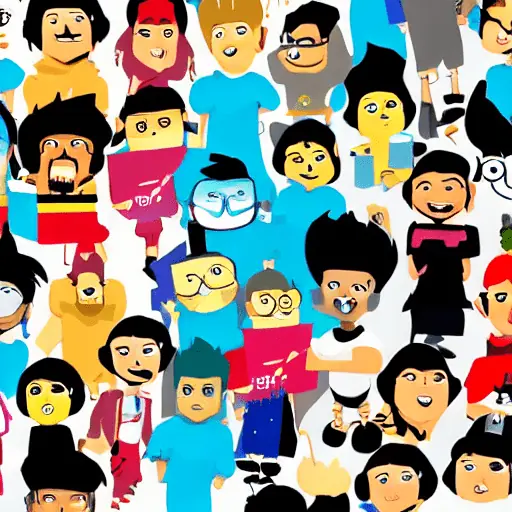
Users are the lifeblood of any marketing strategy. The more users you have, the more opportunities you have to convert them into customers.
A user is defined as a person who uses a particular item, service, or product.
User is important in marketing because it is a key metric for measuring the success of any marketing campaign. The more users you have, the more likely you are to convert them into customers.
Dialogflow users are called agents. Agents are individuals who interact with your customers using automated chatbots on any of the major messaging platforms, including Facebook Messenger and Kik.
Agents can manage their conversations inside Dialogflow’s web interface or via its API (application programming interface). The platform is easy to learn for developers but also simple enough that even non-technical people can use it to create chatbots.
Dialogflow also offers several integrations with other marketing and customer service tools, making it an attractive option for businesses that want to use chatbots as part of a larger strategy.
Manychat users are called bots. Bots are automated chatbots that can be used to interact with your customers on any of the major messaging platforms, including Facebook Messenger and Kik.
Bots can be managed inside Manychat’s web interface or via its API (application programming interface). The platform is easy to learn for developers but also simple enough that even non-technical people can use it to create chatbots.
In terms of users, Dialogflow and Manychat are neck-and-neck. Both platforms have a large user base, and both are growing rapidly. Which platform is right for you depends on your needs and preferences. Dialogflow is more geared towards developers, while Manychat is simpler to use but has fewer integrations. Whichever platform you choose, be sure to keep your users top of mind as you develop and grow your chatbot strategy.
Chatbot Elements
Chatbot elements are important for several reasons. First, they make your chatbot more engaging and interactive. This helps keep users engaged with your chatbot and encourages them to continue using it. Additionally, chatbot elements can help you better understand your users’ needs and preferences. This information can be used to improve your chatbot and provide a better user experience. Finally, chatbot elements help you measure the success of your chatbot.
A chat flow helps organize your bot’s conversation into different branches or flows through which users can follow as they communicate with your bot. By organizing each type of message that could be received into a specific chat flow, you can help ensure that your bot responds in the most logical way possible. Additionally, chat flows make it easy to create and test new interactions with your chatbot. This makes it easier to experiment with new ideas and find the best ways to engage users.
Dialogflow’s chatbot elements are pretty straightforward. There are different types of prompts you can include in your chatbot, each with its own parameters that help determine how the message is handled by the bot. For example, there’s a “Text” type prompt that tells Dialogflow to display some text on the screen and wait for a response from the user before moving forward.
Dialogflow also includes a “Card” type prompt which allows you to show rich media content to users, such as images or videos. Cards can also include buttons that allow users to take specific actions, such as submitting a form or buying a product.
Dialogflow’s “List” type prompt lets you display a list of items to the user and ask them to select one. These prompts can be useful for quizzes, surveys, and other types of polls that require a user to choose an answer from a setlist.
Manychat’s chatbot elements are more complex than Dialogflow’s. First of all, Manychat includes a “Text” type prompt which is very similar to what you would find in Dialogflow or Facebook Messenger. However, this text box can be customized with different types of formatting options using HTML code — for example, it allows users to include links and images within their messages.
Manychat also includes a “List” type prompt which is similar to Dialogflow’s List type prompt. However, Manychat’s list prompts allow you to include multiple items in the list, and users can select more than one item at a time. Additionally, you can add buttons to your lists that allow users to take specific actions, such as submitting a form or buying a product.
Manychat also includes an “Image” type prompt which allows you to include images in your chatbot’s messages. This can be useful for adding visual elements to your bot’s conversations, or for providing instructions and other information to users.
Finally, Manychat includes a “Form” type prompt which allows you to collect information from users. This prompt can be used for collecting contact information, survey responses, or any other type of data that you need from your users.
In terms of chatbot elements, Dialogflow and Manychat are fairly similar. Both platforms include a “Text” type prompt, as well as a “List” type prompt. Dialogflow also includes a “Card” type prompt, while Manychat includes an “Image” type prompt.
However, where Dialogflow excels is in its ability to handle more complex interactions, such as those involving forms or buttons. Manychat excels in its ability to make rich media content available for users through the use of cards and images.
Channels
Channels are a feature that lets you send and receive messages from people on other platforms, including Facebook Messenger, WhatsApp, Telegram, SMS (text message), and more.
Why are channels important in marketing? Because it lets you communicate with your customers on the platforms they’re already using. You can reach a wider audience this way, without needing to create or manage separate accounts.
Dialogflow’s channels are called agents. You can have multiple channels within a single agent, and publish your chatbot to each channel separately. This way you don’t need separate apps for different platforms.
Dialogflow also supports channels like Facebook Messenger, WhatsApp, Telegram, SMS (text message), Phone call, Email, and more.
Dialogflow’s channels also support rich media, including images, videos, and location data. This lets you create richer interactions with your customers.
Manychat’s channels are called bots. You can create as many bots as you want, and each bot can have its own unique set of channels. Supported channels include Facebook Messenger, WhatsApp, Telegram, SMS (text message), and more.
Manychat also lets you create different types of bots, which is a unique feature that allows your chatbot to have separate functions. You can make some bots reply with text only and others respond by speaking a message out loud using TTS (Text-To-Speech).
In terms of channels, Dialogflow and Manychat are fairly equal. Both support Facebook Messenger, WhatsApp, Telegram, SMS (text message), and more. However, Dialogflow supports richer media like images, videos, and location data while Manychat does not. Additionally, Dialogflow lets you create different types of bots while Manychat does not. So if you’re looking for more flexibility in terms of channels and bot types, Dialogflow is a better choice than Manychat.
However, if you’re just starting and don’t need all that extra functionality, Manychat is a good place to start. It’s simpler to use and has all the essential features you need to get started with chatbots.
AI & NLP
AI & NLP marketing are important because they help you automate and personalize your marketing. With AI, you can analyze data to understand customer needs and preferences. NL helps you communicate with customers in their language.
AI is defined as the ability of a computer system to learn and work on its own. NLP is the study of understanding human language. Together, they enable you to create chatbots that can understand customer needs and communicate with them in their language.
The AI & NLP of Dialogflow is based on the Google Cloud Platform. It includes a natural language processing (NLP) engine that understands and interprets customer queries in over 80 languages. Dialogflow also uses machine learning to improve its understanding of customer needs over time.
Dialogflow’s AI & NLP capabilities make it a powerful tool for creating chatbots. It can interpret customer queries and respond in their language. It also uses machine learning to improve its understanding of customer needs over time.
The AI & NLP of Manychat is based on the Facebook Messenger Platform. It includes a natural language processing (NLP) engine that understands and interprets customer queries in over 80 languages. Manychat also uses machine learning to improve its understanding of customer needs over time.
Manychat’s AI & NLP capabilities make it a powerful tool for creating chatbots. It can interpret customer queries and respond in their language. It also uses machine learning to improve its understanding of customer needs over time.
In terms of AI & NLP, Dialogflow and Manychat are similar. They both use machine learning to improve their understanding of customer needs over time. However, Dialogflow has a more advanced natural language processing (NLP) engine that understands queries in 80 languages while Manychat only works with English.
Messages

Messages is a powerful marketing tool that lets you communicate with your customers through chatbots. With Messages, you can create and send automated messages to your customers, keeping them updated on new products, sales, and more. You can also use Messages to answer customer questions and provide support.
Messages are available as a standalone app or as part of Facebook Messenger. It’s free to use, and you can create chatbots without any programming experience.
Dialogflow’s messages feature allows you to send messages at the right time, whether it’s an automated reminder or a personal reply. You can also keep track of all your customer conversations in one place with Dialogflow’s messaging interface.
DialogFlow is a powerful tool for building chatbots and voice assistants that understand natural language queries. The platform supports multiple languages, including English, Spanish, French, Japanese, and more.
Dialogflow is available as a standalone product or as part of Google Cloud. It’s free to use for up to 1000 messages/month, and you can create chatbots without any programming experience.
The messages feature of Manychat lets you send automated messages to your customers. You can use this feature to keep your customers updated on new products, sales, and more. Additionally, you can use Manychat to answer customer questions and provide support.
Manychat is available as a standalone app or as part of Facebook Messenger. It’s free to use for up to 1000 messages/month, and you don’t need to have any programming experience.
Manychat is a great tool for building chatbots and voice assistants that understand natural language queries.
In terms of messages, Dialogflow and Manychat are very similar tools. Both platforms allow you to send messages, answer questions, and provide support. DialogFlow is a better option if you want to use multiple languages in your chatbots or voice assistants; Manychat supports English only.
Marketing
Marketing is the process of creating value for a company through the creation and distribution of products or services. It is important because it allows businesses to reach new customers, grow their brand, and create revenue.
There are many different marketing channels, each with its own strengths and weaknesses. Some common marketing channels include advertising, public relations, social media, and email marketing.
Marketing channels can be divided into two categories: push and pull.
Push marketing is when a company pushes its products or services onto consumers. This type of marketing relies on advertising and promotional efforts to get the word out.
Pull marketing is when customers pull products or services from a company through word-of-mouth or by visiting the business’ website. This type of marketing relies on excellent customer service and quality products to attract customers.
The marketing of Dialogflow is focused on pull marketing. It makes it easy for companies to attract customers by using push notifications, in-app messages, and automated emails that remind users about the product or service.
Dialogflow is great for marketing because it can be used to build highly personalized experiences that are triggered by user-generated content (such as location or time of day). The platform also makes it easy to create automated workflows and includes a deep learning engine that helps businesses personalize customer conversations.
Another way Dialogflow is helpful in the realm of marketing is through its ability to integrate with other technologies such as SalesForce, Slack, and Shopify. This allows businesses to take advantage of existing tools that they already use daily which makes it easy for them.
Manychat’s marketing is focused on push marketing. The platform makes it easy for companies to blast notifications, messages, and emails to large groups of people at once.
Manychat also offers a wide variety of integrations which allows businesses to connect with other platforms such as Shopify, Mailchimp, Google Sheets, Facebook Ads, and more. This gives businesses a lot of flexibility when it comes to how they want to market their product.
Additionally, Manychat has a built-in chatbot that can be used to answer customer questions and automate tasks. This allows businesses to provide 24/hour support without having to hire additional staff.
Manychat is also great for building relationships with customers. The platform allows businesses to send one-to-one messages as well as broadcast messages to large groups of people. This helps companies keep in touch with their customers and build loyalty over time.
In terms of marketing, Dialogflow and Manychat both have strengths and weaknesses.
Dialogflow is best for pull marketing, which makes it great for building relationships with customers over time. The platform also integrates well with other platforms, making it easy to use existing tools when possible. However, Dialogflow lacks integrations compared to Manychat which can be a problem if businesses want to use the platform with other tools.
Manychat is best for push marketing, which makes it great for blasting notifications and messages to large groups of people at once. Additionally, Manychat has a built-in chatbot that can be used to answer customer questions and automate tasks. However, many businesses find that they need to hire additional employees to provide 24/hour support.
One of the biggest strengths about Dialogflow is that its marketing capabilities are focused around pull marketing which makes it great for building relationships with customers over time. The platform also integrates well with other platforms, making it easy to use existing tools when possible. However, many businesses find that they need to hire additional employees to provide 24/hour support.
Additionally, Manychat has a built-in chatbot that can be used for answering customer questions and automating tasks. Businesses get the flexibility of using this feature while still being able to blast notifications and messages to large groups at once with push marketing. However, many businesses find that they need more integrations with other tools compared to Dialogflow.
In summary, both Manychat and Dialogflow have strengths for different types of marketing tactics. However, the biggest difference between them is that Manychat offers more integrations which can be beneficial if businesses want to connect their chatbot with a wide range of third-party services while Dialogflow is focused on pull marketing which can be better if businesses are looking to build long-term relationships with customers.
Integrations
Integrations are a way of connecting two software so they can communicate with each other. Manychat and Dialogflow have integration features that allow you to connect the chatbot to your website or CRM system.
Integrations are important because it allows you to do more than just chat with your customers. It enables the interaction of other systems to make customer service better and faster.
Integrations allow marketers to offer a higher level of service for their users by giving them access to different apps that are used in daily life, like CRMs or SMS messaging apps.
The integrations of Dialogflow are robust and allow for many different possibilities. They are currently integrated with tools like Google Analytics, WordPress, Twitter, Zendesk, or Salesforce to name a few.
The integrations of Dialogflow make it easy to create chatbots that can trigger events in these apps – this is especially useful if you want your bot to look for specific information or take actions based on it.
For example, you could use Dialogflow’s integration with Google Analytics to create a chatbot that responds to website visitors and offers them help or information. You could also use the Twitter integration to create a bot that automatically sends out tweets when certain conditions are met (like new followers or Retweets).
The integrations of Manychat are not as robust as Dialogflow’s, but they are still useful. They are integrated with tools like Facebook Messenger, Shopify, WordPress, and Twitter.
Manychat’s integrations make it easy to create chatbots that automatically send messages or take actions based on certain conditions. For example, you could use the Facebook Messenger integration to create a chatbot that sends out messages to your Messenger subscribers when you publish a new blog post. Or, if you use Manychat with Shopify, the chatbots can automatically send purchase confirmation emails.
Manychat’s integration with WordPress makes it easy to create chatbots that automatically respond to website visitors and post new blog content on your site.
The integrations of Manychat make it an attractive option for marketers who want access to a wide variety of apps without having to learn how they work or hire someone who does. It’s also useful if you already use a particular tool and want a chatbot that works with it.
In terms of integrations, Dialogflow is the clear winner. It has more integrations with a wider variety of apps than Manychat does. This makes it an attractive option for marketers who want to use chatbots for a wide range of tasks.
However, if you’re already familiar with how certain apps work and don’t need help setting up integrations, then Manychat may be a better option for you. It’s simpler to use and doesn’t require as much setup time.
Analytics
Analytic tools are used to monitor the performance of your chatbot.
Analytic tools can be very useful in helping you understand how well your bot is performing and what changes need to be made.
Analytics are important in marketing because it helps you understand what is working within your chatbot.
The analytics of Dialogflow is very thorough.
They show you the number of times certain words are said, what phrases your users use most often, and more!
Dialogflow also provides a heat map feature that shows where on the page people click within your chatbot. This helps understand how to place buttons or links to optimize clicks.
Dialogflow’s analytics is definitely a valuable tool to help you improve your chatbot.
Manychat also offers great analytics.
One of the best features is that it shows you how many people are opening and clicking your messages.
This is a great way to see what content is most popular with your users!
Manychat also has a built-in chatbot reports feature. This allows you to track conversions, engagement, and more.
Manychat’s analytics is a great way to help you improve your chatbot.
In terms of analytics, both Dialogflow and Manychat provide great tools for monitoring the performance of your chatbot.
Dialogflow’s analytics are very thorough, offering information about user behavior as well as heat maps to help you understand how users interact with your bot.
Manychat is a good choice too because it offers data on open rates and click-throughs, which can help you understand what content is most popular with your users.
Overall, both of these analytics tools are valuable for helping you improve your chatbot.
Templates & Cloning
Templates & cloning are important because they help you save time and effort when creating new content. By using templates, you can create a basic structure for your content that can be easily customized to fit your needs. Cloning allows you to quickly create multiple versions of the same content, making it easier to reach more people with your message.
Templates are pre-made structures that you can use as a foundation for your content. They allow you to create a basic structure for your content that can be easily customized to fit your needs. This saves time and effort when creating new content, and ensures that all of your content is cohesive and on-brand.
Cloning allows you to quickly create multiple versions of the same content, making it easier to reach more people with your message. This is a powerful way for marketers who need to publish new messages on social media or in blog posts very frequently and don’t have time to start from scratch every single time.
The templates & cloning of Dialogflow are similar to the templates & cloning of ManyChat.
Dialogflow offers both pre-made and custom templates, which you can use as a foundation for your content. These are helpful if you need to create new messages or chatbots on social media very frequently because they allow you to quickly customize them based on an existing template (and clone them to create multiple versions). You can also use cloning to create multiple versions of the same chatbot. This is a great way to test different messages and strategies to see which ones work best for your audience.
Dialogflow’s templates are very powerful and can be a great way to save time when creating content.
ManyChat, on the other hand, doesn’t offer any pre-made or custom templates. This can be a drawback if you need to create new content very frequently because it means that every time you want to start from scratch.
ManyChat does, however, have cloning capabilities that allow you to quickly create multiple versions of the same chatbot and test different messages on your audience until you find what works best.
In terms of the templates & cloning, Dialogflow and Manychat are very similar. Both offer pre-made and custom templates, as well as the ability to clone content. They both have powerful options for creating multiple versions of the same content, making it easier for you to reach more people with your message.
Which chatbot tool is right for you will depend on your specific needs, but both are great options!
eCommerce
eCommerce is the process of buying and selling goods and services over the internet. It has become a key part of marketing, as more and more people are shopping online. eCommerce allows businesses to reach a wider audience than they could through traditional methods like storefronts or telemarketing.
There are many different platforms for eCommerce, but two of the most popular are Shopify and BigCommerce. These platforms offer merchants a way to set up their own stores from the ground up, as well as fulfill orders through secured payment options.
eCommerce is not just for businesses, either. Individuals can also use these platforms to sell products they create themselves, or items they have found online.
Dialogflow’s eCommerce capabilities allow businesses to create and manage orders for products and services. You can use Dialogflow’s eCommerce features to create, manage, and fulfill orders for products and services; set up a payment gateway to process payments; manage inventory levels; automate order fulfillment processes; and more.
Dialogflow’s eCommerce features are available in all paid plans. To learn more, visit our pricing page.
The eCommerce of Manychat allows you to create and manage customer accounts; set up a payment gateway to allow customers to pay for products or services; send automated emails that support your sales process; track all customer data, such as purchase history and spending habits.
In terms of eCommerce, Dialogflow and Manychat offer similar features. However, Dialogflow’s eCommerce capabilities are more comprehensive, offering businesses more control over their order fulfillment processes. Additionally, Dialogflow integrates with a wider range of payment gateways than Manychat. If you’re looking for a chatbot tool that can help you manage your eCommerce operations, Dialogflow is probably a better choice.
Support
Support is important in marketing because you need to provide your customers with a way of getting help and finding answers.
Support can come in many forms, such as customer service, FAQs, and social media.
Support is defined as assisting customers who need it. This includes answering questions, addressing complaints, and helping customers resolve problems.
Providing a way for your customers to contact you is essential in any business. In the digital age, providing support through chatbots is becoming increasingly popular.
The support of Dialogflow is very comprehensive. It includes a wide range of features, such as the ability to create custom responses, manage customer data, and track chatbot analytics.
You can also use Dialogflow to create integrations with other services, such as Google Sheets and Gmail. This allows you to collect customer data and send automated messages.
Dialogflow lets you create rich, flexible chatbot conversations in minutes. You can use responses built by the community or build your own to handle any situation.
Dialogflow also offers a wide range of integrations, which allows you to connect your chatbot with other services. This helps you collect customer data and send automated messages.
Manychat’s support is more limited but still helpful. It includes an interactive guide that explains how to create a chatbot and use the platform’s features.
Manychat also has integration with MailChimp, allowing you to automate email marketing campaigns based on specific criteria. This allows you to send messages only when they are needed most.
With Manychat, creating your first chatbot is easy. The interactive guide walks you through the process and helps you get started quickly. And, with integrations with MailChimp, you can automate email marketing campaigns based on specific criteria. This allows you to send messages only when they are needed most.
In terms of support, Dialogflow offers more features, but Manychat is easy to use.
Both DialogFlow and Manychat have their pros and cons when it comes to support. While they are very different from each other in many ways, there’s no clear winner when it comes to supporting. So, it’s up to you to decide which chatbot tool is right for your needs.
Pricing
Pricing is important in marketing because it can help you determine the value of your product or service. It also helps customers understand what they are getting for their money. Generally, pricing should be fair and reflect the quality of your product or service. You may also want to consider offering different pricing options to meet the needs of your customers.
For example, an e-commerce website might charge more for products with features that customers can’t get elsewhere. Another option is to offer different pricing plans depending on the services your business offers and what you think your target market will find appealing.
Pricing is also important when choosing between two or more products.
The pricing of Dialogflow is based on the number of messages your chatbot can send each month. You also need to pay for the use of natural language processing, which is how Dialogflow understands and responds to customer questions.
Dialogflow is $0.003 per message for the first 100,000 messages and then drops to $0.0025 per message after that.
Dialogflow also charges a flat fee of $399 each month if your chatbot sends fewer than 40,000 messages in one month or you use natural language processing for less than 400 minutes for the entire billing cycle.
The pricing of Manychat is based on the number of subscribers your chatbot has. You pay $49 per month for up to 100 subscribers and then $99 per month if you have more than 100 subscribers.
Manychat also charges a flat fee of $299 each month if your chatbot sends fewer than 20,000 messages in one month or you use natural language processing for less than 2000 minutes for the entire billing cycle.
In terms of pricing, Dialogflow is more expensive than Manychat. However, Dialogflow offers more features and processing power, which can be important if you want to create a sophisticated chatbot. Manychat is good for simpler chatbots that don’t require as much processing power. Ultimately, the decision about which chatbot tool to use depends on your needs and budget.
Conclusion
Pricing is important in marketing because it can help you determine the value of your product or service. It also helps customers understand what they are getting for their money. Generally, pricing should be fair and reflect the quality of your product or service. You may also want to consider offering different pricing options to meet the needs of your customers.
For example, an e-commerce website might charge more for products with features that customers can’t get elsewhere. Another option is to offer different pricing plans depending on the services your business offers and what you think your target market will find appealing.
Pricing is also important when choosing between two or more products.
The pricing of Dialogflow is based on the number of messages your chatbot can send each month. You also need to pay for the use of natural language processing, which is how Dialogflow understands and responds to customer questions.
Dialogflow is $0.003 per message for the first 100,000 messages and then drops to $0.0025 per message after that.
Dialogflow also charges a flat fee of $399 each month if your chatbot sends fewer than 40,000 messages in one month or you use natural language processing for less than 400 minutes for the entire billing cycle.
The pricing of Manychat is based on the number of subscribers your chatbot has. You pay $49 per month for up to 100 subscribers and then $99 per month if you have more than 100 subscribers.
Manychat also charges a flat fee of $299 each month if your chatbot sends fewer than 20,000 messages in one month or you use natural language processing for less than 2000 minutes for the entire billing cycle.
In terms of pricing, Dialogflow is more expensive than Manychat. However, Dialogflow offers more features and processing power, which can be important if you want to create a sophisticated chatbot. Manychat is good for simpler chatbots that don’t require as much processing power. Ultimately, the decision about which chatbot tool to use depends on your needs and budget.

